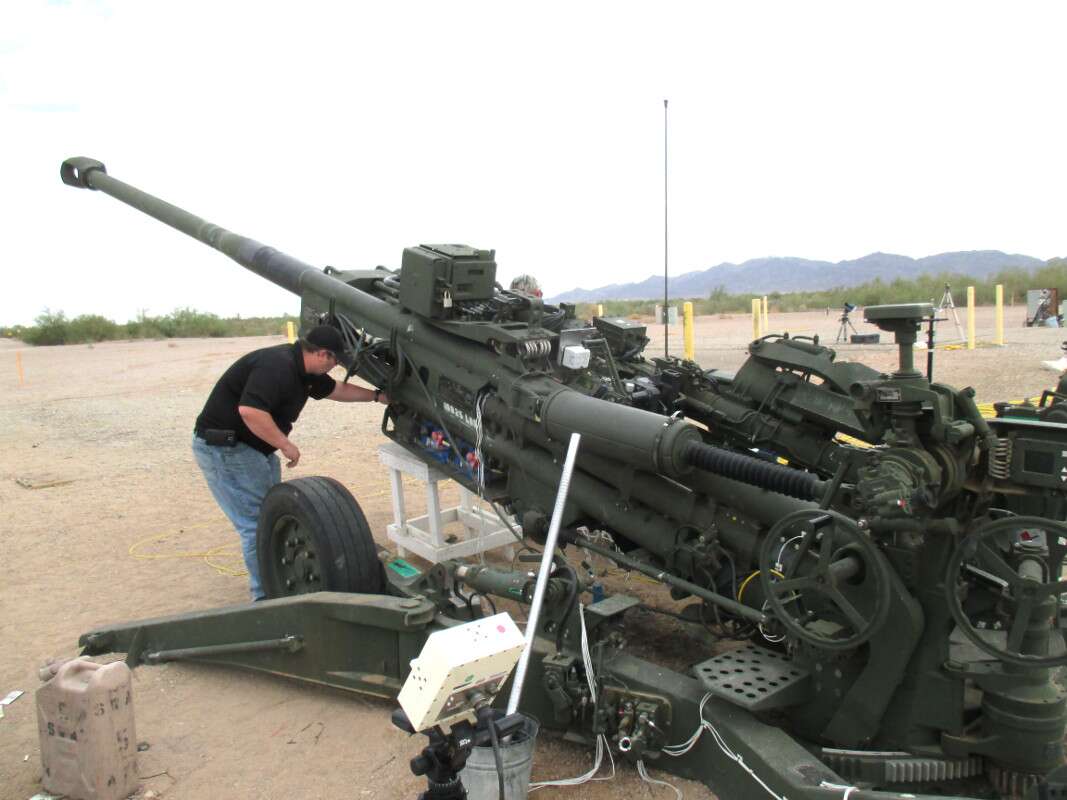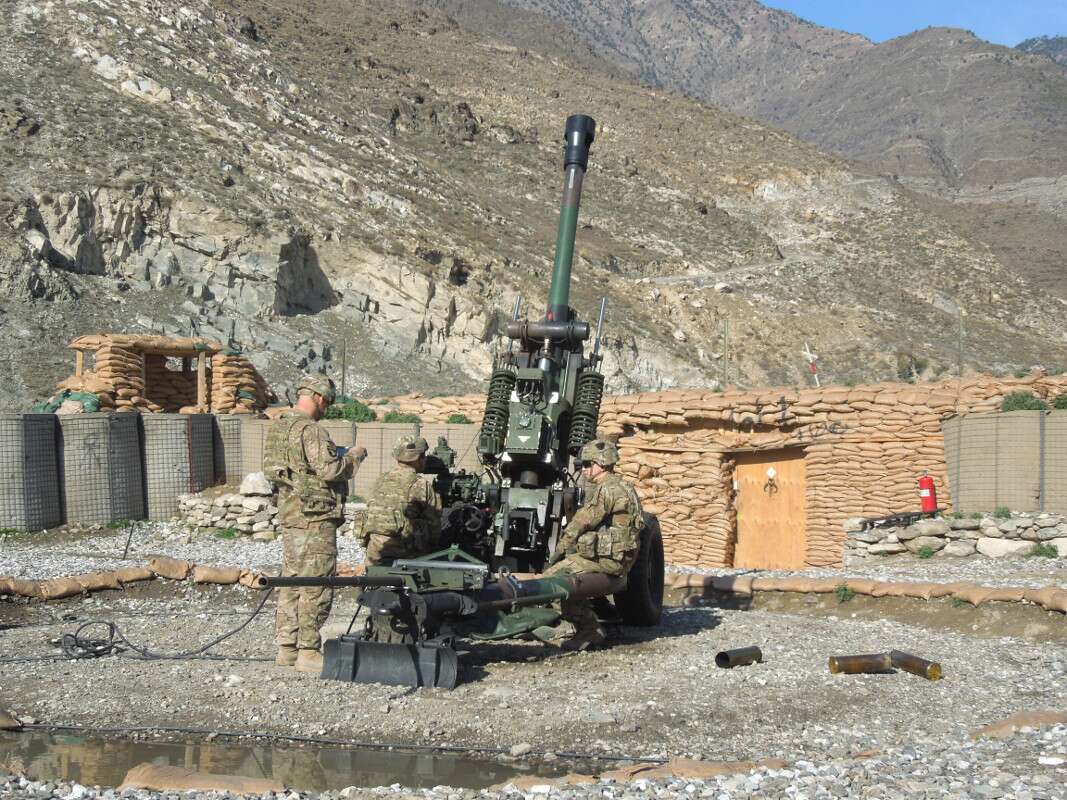US Army Eyes Replacing Its 105mm and 155mm Towed Howitzers With One New Cannon
The service wants more mobile and portable weapons for its light infantry and Stryker units that are still powerful and accurate.
BY JOSEPH TREVITHICK FEBRUARY 16, 2018
US ARMY
The U.S. Army is soliciting ideas for a single new howitzer to replace all of the towed 105mm and
155mm types in
its Stryker-equipped and regular light infantry brigades. The service says it is particularly interested in upgrades for or modification to its existing weapons, especially lightweight 155mm cannons, or various types of self-propelled guns, though it is willing to consider other concepts.
On Feb. 14, 2018, the Army
announced it would be studying its options for this “next generation” howitzer in a notice on the U.S government’s main contracting website FedBizOpps. Though there are no firm requirements as of yet, the new weapons would have to be at least as portable and lightweight as the existing
105mm M119 and
155mm M777 towed howitzers, but hopefully have better range and accuracy and be more mobile.
THE ARMY EYES GETTING INTO THE SHIP KILLING BUSINESS WITH THIS CRUISE MISSILEBy Joseph TrevithickPosted in
THE WAR ZONE
MARINES "BURNED OUT" TWO HOWITZER BARRELS DURING THE RAQQA OFFENSIVEBy Joseph TrevithickPosted in
THE WAR ZONE
U.S. MARINES SECRETLY SET UP ARTILLERY BASE NORTH OF RAQQABy Joseph TrevithickPosted in
THE WAR ZONE
US MARINES WANT PINT-SIZED ROCKET ARTILLERY THEY CAN CARRY IN AN MV-22 OSPREYBy Joseph TrevithickPosted in
THE WAR ZONE
HIMARS GOES TO SEA: US MARINES NOW FIRE GUIDED ARTILLERY ROCKETS FROM SHIPSBy Joseph TrevithickPosted in
THE WAR ZONE
In the notice, the Army was clear that it is just doing “market research” and is not looking to buy any new weapons at the moment. However, it added that it was looking for designs that could be ready sometime in the mid-2020s and wouldn’t require an “extended development cycle.”
The M119 has a maximum range of around eight and half miles, while the M777 can hit targets nearly 20 miles away using special long-range ammunition. The 155mm guns can also fire GPS-guided artillery shells. Both weapons require trucks to move them around on the ground, but are light enough for cargo planes to air drop or helicopters to shuttle around the battlefield, as well.
At present, the service’s infantry and Stryker brigades, which are the easiest maneuver units for the service to deploy in a crisis, rely entirely on these towed howitzers for organic, stand-off fire support. A typical infantry brigade has two batteries of M119s and one with M777s, while standard Stryker brigades just have the 155mm weapons.
Since 2016, the Army has already been working on
a new M777 variant with double the range, but not a dramatic increase its weight compared to the standard version. The problem there is whether the modified howitzer’s longer barrel makes it harder to move, especially over rough, uneven ground, where it might twist and bend as a truck pulls it along.
US ARMY
One of the Army's prototype extended-range M777 howitzers.
An upgrade for the 155mm weapon also does nothing to address the limitations of the smaller M119, which is light enough for a Humvee to tow around, making it better suited for certain airborne or other limited operations. The latest variant of this 105mm has a digital fire control system that includes GPS and inertial navigation systems to better determine its own location and by extension the exact position of and distance to the target. It does not have the ability to fire a precision guided shell, though.
This is likely why the Army is interested in the possibility of an 155mm weapon that it could configure in long- and short-tube versions. The shorter barrel variant would have more limited range and accuracy, but might be able to fire the full range of existing ammunition types, including precision guided rounds. It could still be hard to trim weight from the system, though, since it would still need a robust frame to handle the recoil of firing those loads.
US ARMY
US Army soldiers man an M119 howitzer in Afghanistan.
It wouldn’t be the first time the service has looked into ways to get at least some of the range and firepower benefits of a full-size 155mm weapon in a more compact package. During the Cold War, it experimented with the XM204, a “soft-recoil” gun available in both 105mm and 155mm calibers that used a complicated recoil mechanism known as the “Fire Out of Battery” system.
What this meant was that when a gunner fired the weapon, the entire barrel assembly would actually shoot forward, as well, sealing the shell “in battery” in the firing chamber in the process. In theory, that momentum would help cancel out the rearward recoil, allowing the entire system to be lighter and more manageable. Despite years of research and development, including a bizarre idea to bolt two XM204s to the side of a CH-47 Chinook, the Army canceled the overly complicated howitzer.
The video explains the XM204's "Fire Out of Battery" system.
Many of the same basic issues apply to lightweight self-propelled systems. Wheeled 155mm howitzers are becoming increasingly popular, especially among America’s NATO allies, as a cost-effective alternative to heavy tracked systems. The lighter weight vehicles have more limited off-road mobility, though, and could present a less stable, and therefore less accurate, firing platform.
Computerized ballistic targeting systems and precision guided shells could help mitigate accuracy concerns, but wouldn’t make the vehicles any more portable or mobile. France’s
CASEAR, one of the most popular wheeled 155mm howitzers presently on the market and a good general representation of the options available, is not light enough for air drop or for a helicopter to rapidly move it from one position to another, though it is air-portable using fixed-wing cargo aircraft.
DANIEL STEGER VIA WIKIMEDIA
A French CAESAR wheeled self-propelled 155mm howitzer.
Defense contractor
Mandus Group has been working on an 105mm system called Hawkeye that is lightweight and low recoil enough to fit onto smaller vehicles, including commercial pickup trucks, which that could offer another option. The Army might be able to squeeze some 155mm-like effects out of an 105mm cannon with extended range, precision guided ammunition, but its unlikely that the smaller bore weapon would ever have truly comparable capabilities.
But it’s not hard to understand why the Army might be interested in new, more mobile, lightweight artillery pieces. Having that kind of firepower on-call is immensely important for the Army’s light infantry and Stryker units, especially when conducting independent operations where they might not have the guarantee of support from other services or even other elements within the Army.
Unless there are already aircraft overhead or other artillery units in position nearby, the howitzers can often respond faster to requests for fire missions, too. The guns don’t get grounded due to bad weather, either.
The value of this flexible fire support has been particularly visible in the fight against ISIS in
Iraq and Syria, where Marine and Army units were able to quickly set up fire support bases in remote, austere locations with their M777 howitzers. In Syria, Marine artillery elements
were a key part of the offensive
to eject the terrorists from their
de facto capital of Raqqa and more
recently helped beat back a contingent of Syrian forces
and Russian mercenaries near the city of Deir ez-Zor.
The Army has also employed tracked M109 self-propelled 155mm weapons to Iraq to provide artillery fire for coalition operations. French forces employed their CAESARs to great effect, as well.
On top of that, further underscoring the value of ground-based, precision artillery fire, Army and Marine units brought in truck-mounted High Mobility Artillery Rocket Systems,
or HIMARS. These vehicles offer ground forces the ability to rapidly and accurately engage targets more than 50 miles away with 227mm GPS-guided rockets and quickly became stars of the campaign to defeat ISIS.
These same capabilities would almost certainly be important in a larger, conventional fight against a near-peer adversary or a smaller nation state opponent. In particular, the Army has cited Russia’s significantly more diverse tube and rocket artillery forces as an important reason to modernize its own such capabilities. Since 2014, Russian troops have employed those weapons to devastating effect in support of pro-Kremlin separatists
in Eastern Urkaine and more recently
as part of operations on behalf of dictator Bashar al Assad in Syria.
“Russia has shown the capability to rapidly bring massive amounts of indirect fire (IDF) onto a target once they have positive identification,” a 2016
Army handbook on that country’s “New Generation Warfare” tactics explains. “The threat of massed artillery and Multiple Launched Rocket Systems (MLRS) denies friendly forces a ‘safe haven.’ Forward Operating Bases (FOB), which U.S. formations have become accustomed to are not possible in this environment.”
VITALY KUZMIN
A pair of Russian 2S19M1 Msta-S 152mm self-propelled howitzers
Improving the range, accuracy, and mobility of the artillery systems available to infantry and Stryker brigades could give them additional options to respond to those threats. It would also give the Army more ways to quickly set up distributed fire support sites without having to rely on pre-existing, well established, and therefore vulnerable bases.
Lightweight, mobile artillery systems could also be more flexible in a maritime environment, making use of
U.S. Navy ships and
Army watercraft to rapidly reposition from one area to another. Especially in the Pacific region, quickly placing guns or
other stand-off weapons on a small island might allow a ground force to better support distributed operations to disrupt an enemy’s plans or defend other higher value assets from counter-attacks.
The Army own recent experiences in Iraq and Syria, as well as other trends around the world, are proof artillery is still a central part of any combined arms force and that it is essential for the service to modernize and improve its capabilities in this regard. This is perhaps nowhere more apparent than in the service's most recent budget proposal for the 2019 fiscal year that includes a request for a more than
800% increase in purchases of 155mm high explosive shells alone.
So, it will be interesting to see what defense contractors can come up with as options for replacing its M119 and M777 towed howitzers.
Contact the author: [email protected]
 USAllakin panssaridivisioonan nimenä ratsuväkidivisioona, kunnioittaa perinteitä, vaikka on todellisuudessa ihan normaali panssaridivisioona osana III Corpsia. Eli suomellakin voisi joskus olla jokin yksikkö jonka nimi olisi perinteitä kunnioittaen joku "Turun rannikkopatteri", vaikka olisi oikeasti samanlainen kuin muutkin tykistön osat kalustoltaan jne. Olen huono selittämään
USAllakin panssaridivisioonan nimenä ratsuväkidivisioona, kunnioittaa perinteitä, vaikka on todellisuudessa ihan normaali panssaridivisioona osana III Corpsia. Eli suomellakin voisi joskus olla jokin yksikkö jonka nimi olisi perinteitä kunnioittaen joku "Turun rannikkopatteri", vaikka olisi oikeasti samanlainen kuin muutkin tykistön osat kalustoltaan jne. Olen huono selittämään 


 ; tykistö/heittimistö on tarkoitettu aluemaaleihin ja jos ei kantama riitä, menee lähemmäs
; tykistö/heittimistö on tarkoitettu aluemaaleihin ja jos ei kantama riitä, menee lähemmäs




